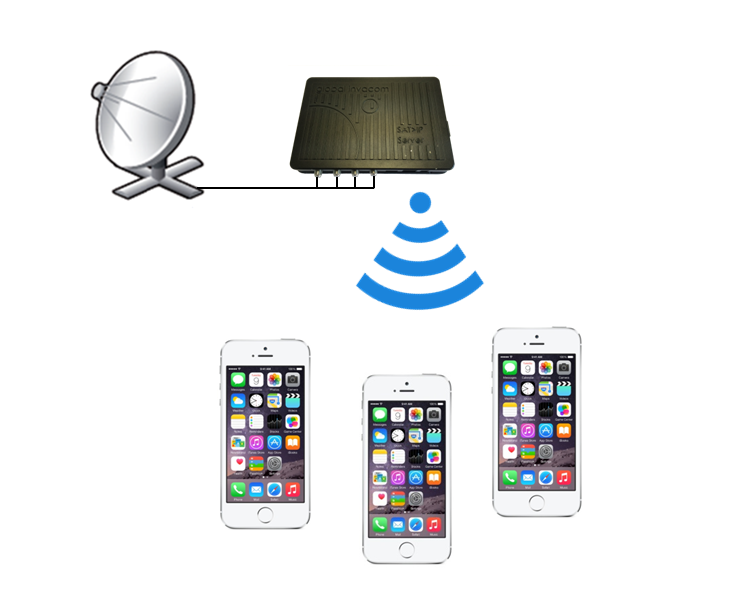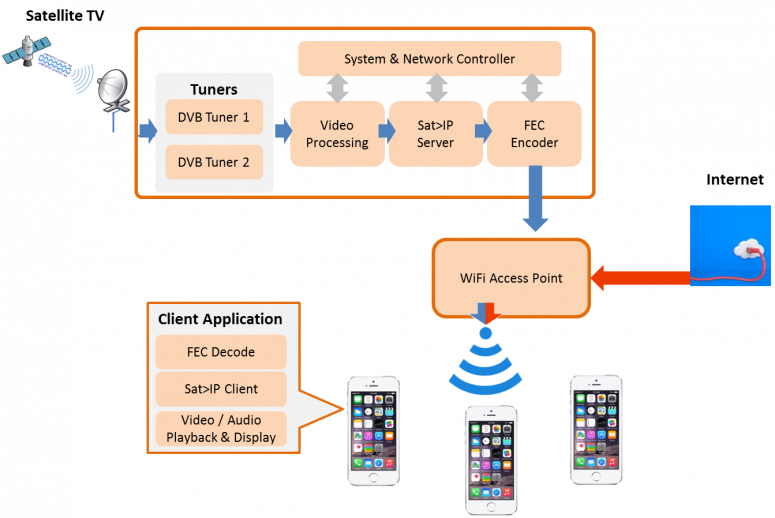-
StatusOngoing
-
Status date2018-05-22
The main objective was to show how to reliably distribute multiple live broadcast Satellite TV channels over a wireless IP network using multicast to multiple mobile client devices. In this R&D project we have aimed to develop an initial demonstration / proof of concept that would allow us to engage with prospect customers and specify market- or broadcaster- specific products. The demonstrator would support switching between two transcoded video streams that are multicast over the wireless network (and received via satellite). To assure video quality we have applied FEC and we have aimed at also enabling the use of broadband over the same WiFi access point.

For this initial proof of concept, there were a few critical challenges that we were trying to resolve. While we are confident that we can deliver a solution for the transcoding, it was possible that the available transcoding options to support the processing of many streams would result in an impractical or cost prohibitive device. In addition, we believed that implementing FEC will be workable, however it is possible that most optimal way to integrate FEC and SAT>IP is a larger work task than estimated.
Previously end users could potentially watch live TV in public spaces using internet-streaming applications, either over a mobile data connection or via a free WiFi access point. Both of these options have drawbacks:
- Users will be using the data allowance of their mobile subscription plane and potentially have costly bills.
- Use of free WiFi access points are popular but the user experience is poor due to limited available bandwidth making internet browsing slow and watching video impossible.
The Sat>IP WiFi Hotspot however provides the possibility to
- Receive broadcast quality TV and radio anywhere, via satellite
- Stream the content via multicast, making very efficient use of WiFi capacity
- Remove the Live TV content from the broadband network, freeing it up for general internet browsing.
- More reliable broadband connection due to de-congestion
- Higher quality video possible for larger mobile devices or fixed displays
- Access mobile video in not-spot or poor broadband areas
Below is a list of the major features that we have implemented:
- The device connects to one or several external WiFi access points (Global Invacom certified / supplied).
- Additional tuner/demodulator processing cards can be added for simultaneous channels.
- The number of TV and radio streams is configurable, depending on wireless and encoding settings in the device:
- Channel output resolution and bitrate
- FEC is required
- Modulation Coding Scheme (MCS) is required
- Ratio of multicast TV/Radio to Internet bandwidth
- All streams need to be sent via multicast with FEC applied
- Encryption of the streams shall be possible
- Ability to access, configure and monitor status, performance or servicing software updates to the device remotely
A block diagram of the SAT>IP WiFi hotspot is shown in the diagram below, it consists of several key components and technologies:
- DVB Tuners
- Video Processing
- SAT>IP server
- Forward Error Correction (FEC)
- WiFi Access Point
- Client Application

WP1 Sat>IP
WP2 FEC
WP3 Transcoding
WP4 Multicast / IP configuration
WP5 Network testing and understanding
WP6 Mobile / Tablet client Application
WP7 Integration of Demonstration Platform
WP8 Proof of concept demonstration
WP9 Project Management
All technical work has now been completed following CCN001



